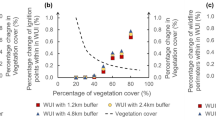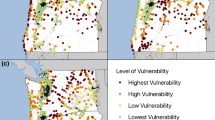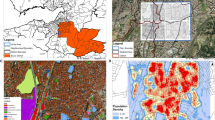Abstract
In recent years, with the rapid expansion of urban space and the explosion of population within communities in China, fire stations face challenges in providing timely response to potential demands throughout their service coverage. To ensure speedy and equitable provision of fire services, it is essential to evaluate the accessibility of fire stations under the current fire service systems. Traditional accessibility analysis is often based on the aggregated large areal units, such as the census tracks, failing to assess accessibility of individual buildings. In this regard, this study seeks to analyze potential accessibility to urban fire stations at a fine scale, i.e., the building level, and to provide valuable information to assist in strategic planning of fire stations in urban areas and within local communities. Because the detailed intra-community roads are not stored in the official city map database, we propose to use a classic GIS technology, the Delaunay triangulation model, to automatically extract the intra-community roads from building footprints. With these private roads integrated into the existing city roads, a simulated road network is constructed. Then, the Voronoi-based method and buffering method are used to assess accessibility to urban fire stations. Results reveal that the current layout of fire stations in the study area is not sufficient to achieve a complete coverage of potential demands in the stipulated time, and the traditional central areas enjoy better access to fire services compared to the periphery areas. The building-level analyses will not only enable decision-makers to strategically allocate new fire stations in the urban areas, but also help local authorities to enhance fire safety management within the community. The proposed method can also be applied to fine-scale analysis of neighborhood services’ accessibility in other cities.
















Similar content being viewed by others
References
Black J, Conroy M (1977) Accessibility measures and the social evaluation of urban structure. Environ Plann A 9(9):1013–1031
Bryant J, Delamater PL (2019) Examination of spatial accessibility at micro- and macro-levels using the enhanced two-step floating catchment area (E2SFCA) method. Ann GIS 25(3):219–229
Challands N (2010) The relationships between fire service response time and fire outcomes. Fire Technol 46(3):665–676
Chen H, Cheng T, Ye X (2019) Designing efficient and balanced police patrol districts on an urban street network. Int J Geogr Inf Sci 33(2):269–290
Chen Y, Li Y, Wu G, Zhang F, Zhu K, Xia Z, Chen Y (2021) Exploring spatiotemporal accessibility of urban fire services using real-time travel time. Int J Environ Res Public Health 18:4200
Condeço-Melhorado A, Reggiani A, Gutiérrez J (2018) New data and methods in accessibility analysis. Netw Spat Econ 18:1–4
Curtis C, Scheurer J (2010) Planning for sustainable accessibility: developing tools to aid discussion and decision-making. Prog Plann 74(2):53–106
Dong X, Li Y, Pan Y, Huang Y, Cheng X (2018) Study on urban fire station planning based on fire risk assessment and GIS technology. Proc Eng 211:124–130
Fire and Rescue Department Ministry of Emergency Management (FRDMEM) (2019) https://www.119.gov.cn/article/3xBeEJjR54K
García-Palomares JC, Gutiérrez J, Cardozo OD (2013) Walking accessibility to public transport: an analysis based on microdata and GIS. Environ Plann B 40(6):1087–1102
Geurs KT, Wee BV (2004) Accessibility evaluation of land-use and transport strategies: review and research directions. J Transp Geogr 12(2):127–140
Hooper P, Boruff B, Beesley B, Badland H, Giles-Corti B (2018) Testing spatial measures of public open space planning standards with walking and physical activity health outcomes: findings from the Australian national liveability study. Landsc Urban Plan 171:57–67
Kiran KC, Corcoran J (2017) Modelling residential fire incident response times: a spatial analytic approach. Appl Geogr 84:64–74
Kiran KC, Corcoran J, Chhetri P (2020) Measuring the spatial accessibility to fire stations using enhanced floating catchment method. Socio-Econ Plan Sci 69:100673
Kwan M, Murray AT, O’Kelly ME, Tiefelsdorf M (2003) Recent advances in accessibility research: representation, methodology and applications. J Geogr Syst 5(1):129–138
Logan TM, Williams TG, Nisbet AJ, Liberman KD, Zuo CT, Guikema SD (2017) Evaluating urban accessibility: leveraging open-source data and analytics to overcome existing limitations. Environ Plann B 46(5):897–913
Luo W, Wang F (2003) Measures of spatial accessibility to health care in a GIS environment: synthesis and a case study in the Chicago Region. Environ Plann B 30(6):865–884
Macedo J, Haddad M (2015) Equitable distribution of open space: using spatial analysis to evaluate urban parks in Curitiba. Brazil Environ and Plann B 43(6):1096–1117
Mao K, Chen Y, Wu G, Huang J, Yang W, Xia Z (2020) Measuring spatial accessibility of urban fire services using historical fire incidents in Nanjing. China ISPRS Int J Geo-Inf 9:585
Ministry of Housing and Urban-Rural Development of the People’s Republic of China (MOHURD) (2017) Construction standard of urban fire station. http:// www.mohurd.gov.cn/wjfb/201710/t20171017_233610.html>
Ministry of Housing and Urban-Rural Development of the People’s Republic of China (MOHURD) (2018) Code for fire protection design of buildings. http:// www.mohurd.gov.cn/wjfb /201805/t20180509_235971.html>
Murray AT (2013) Optimising the spatial location of urban fire stations. Fire Saf J 62:64–71
Nanjing Municipal Bureau Statistics (NBMS) (2016) Statistical yearbook of Nanjing (2016). China Statistics Press, Beijing
Nanjing Municipal Public Security Fire Department (NMPSFD) (2016) http://www.nj119.com.cn/>
Oh K, Jeong S (2007) Assessing the spatial distribution of urban parks using GIS. Landsc Urban Plann 82(1):25–32
Okabe A, Satoh T, Furuta T, Suzuki A, Okano K (2008) Generalized network Voronoi diagrams: concepts, computational methods, and applications. Int J Geogr Inf Sci 22(9):965–994
Omer I (2006) Evaluating accessibility using house-level data: a spatial equity perspective. Comput Environ Urban Syst 30(3):254–274
Preparata FP, Shamos MI (1985) Computational geometry: an introduction. Springer-Verlag, Berlin
Shahparvari S, Fadaki M, Chhetri P (2020) Spatial accessibility of fire stations for enhancing operational response in Melbourne. Fire Saf J 117:103149
Talen E (2003) Neighborhoods as service providers: a methodology for evaluating pedestrian access. Environ Plann B 30(2):181–200
Tang BS, Wong KK, Tang KS, Wai Wong S (2021) Walking accessibility to neighbourhood open space in a multi-level urban environment of Hong Kong[J]. Environ Plann B 48(5):1340-1356
Vargas-Muñoz JE, Srivastava S, Tuia D, Falcao AX (2020) OpenStreetMap: challenges and opportunities in machine learning and remote sensing[J]. IEEE Geosc Rem Sen M 9(1):184-199
Wachs M, Kumagai TG (1973) Physical accessibility as a social indicator. Socio-Econ Plan Sci 7(5):437–456
Ware JM, Jones CB, Bundy GL (1995) A triangulated spatial model for cartographic generalisation of areal objects. Springer, Berlin
Widener MJ, Farber S, Neutens T, Horner M (2015) Spatiotemporal accessibility to supermarkets using public transit: an interaction potential approach in Cincinnati. Ohio J Transp Geogr 42:72–83
Xia Z, Li H, Chen Y, Yu W (2019) Integrating spatial and non-spatial dimensions to measure urban fire service access. ISPRS Int J Geo-Inf 8:138
Yao J, Zhang X, Murray AT (2019) Location optimization of urban fire stations: access and service coverage. Comput Environ Urban Syst 73:184–190
Yu W (2017) Assessing the implications of the recent community opening policy on the street centrality in China: a GIS-based method and case study. Appl Geogr 89:61–76
Yu W, Chen Y, Guan M (2021) Hierarchical siting of macro fire station and micro fire station[J]. Environ Plann B 48(7):1972-1988
Funding
National Natural Science Foundation of China,42071442,Wenhao Yu, Fundamental Research Funds for the Central Universities,China University of Geosciences (Wuhan),CUG170640,Wenhao Yu
Author information
Authors and Affiliations
Corresponding author
Additional information
Publisher's Note
Springer Nature remains neutral with regard to jurisdictional claims in published maps and institutional affiliations.
Rights and permissions
About this article
Cite this article
Yu, W., Huang, Y., Chen, Y. et al. Accessibility analysis of urban fire stations within communities: a fine-scale perspective. J Geogr Syst 24, 611–640 (2022). https://doi.org/10.1007/s10109-022-00381-x
Received:
Accepted:
Published:
Issue Date:
DOI: https://doi.org/10.1007/s10109-022-00381-x




